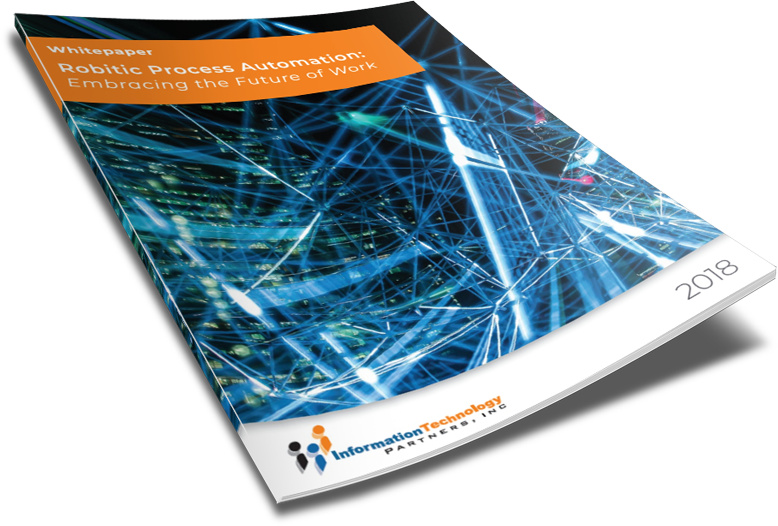TAKE NOTE (Insights and Emerging Technology)

The annual “Christmas in September” spending season is well under way, with billions of dollars that that need to be allocated before the government’s fiscal year ends Sept 30.
The need to spend may be especially acute this year as supply chain issues and Congress’ habit of passing continuing resolutions instead of new budgets, a practice borne of political gridlock, ties the hands of agency procurement officials, leaving them with a backlog of requests and less time left to fill them..
Though agencies tend to spend most of their discretionary dollars before July 1, data shows that the largest splurges in contract awards in any one month of the year have happened in September. What’s the rush? Any unused funds will be returned to the Department of the Treasury as of Oct. 1, and the “use-it-or-lose-it” bonanza of buying has become an annual autumn tradition in Washington.
Fourth quarter spending for this year on procurement could exceed $200 billion, an analysis by Bloomberg Government estimated.
In the last quarter, sole-source awards and single-bid competitions tend to increase because the government can move quickly on them.
Though what agencies spend their sprint money on has come under fire for being frivolous or wasteful, the most popular spending category is professional and administrative services.
The least popular spending category at this stage is for physical science programs, which play a larger role for agencies like the National Institutes of Health.
More broadly, the federal government spends large chunks of its budget on Medicare, social security and defense needs, although funding for income security rocketed at the start of the COVID-19 pandemic.
In total, 2022 discretionary appropriations are 8% more than last year’s.
Still, past years’ last-minute purchases have led members of Congress and unions to scrutinize the final transactions of the fiscal year.
“This ‘use-it-or-lose-it’ feature of time-limited budget authority has the potential to result in low-value spending, since the opportunity cost to organizations of spending about-to-expire funds is effectively zero,” said a report by Harvard University School of Government. “Exacerbating this problem is the incentive to build up a rainy day fund over the front end of the budget cycle.”
Members of Congress have proposed legislation to limit an agency’s discretionary spending in the last two months of the fiscal year, but no progress has been made.
Interested in learning more about RPA? Download our FREE White Paper on “Embracing the Future of Work”
UNDER DEVELOPMENT (Insights for Developers)
Demystifying the BTP (SAP Business Technology Platform) – Part 2
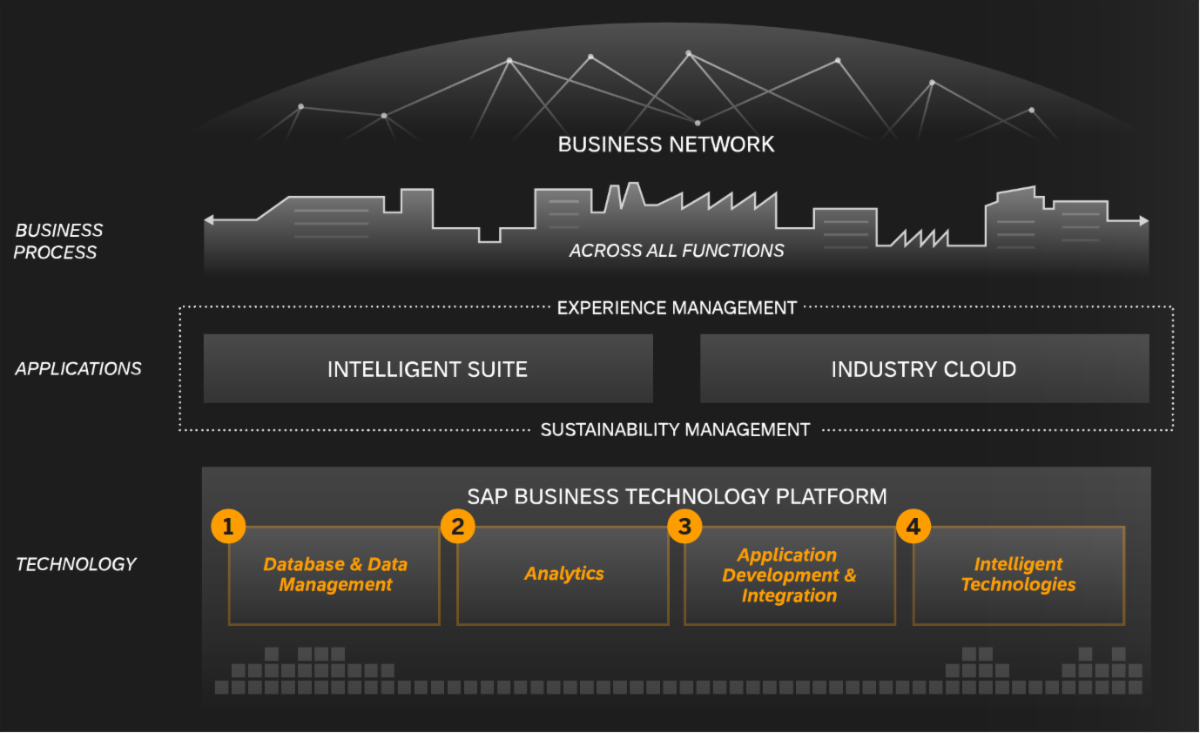
Intro
Back this month is Jon Andre with another great SAP blog. This time Jon gives an overview on the Business Technology Platform
The transition to cloud-based software solutions in the past decade plus has changed the ERP landscape forever. Many customers have ditched the more expensive on-premise system model for a more cost effective and scalable cloud-based ERP SaaS (Software as a Service) route. . In an effort to address this issue, SAP began offering a new cloud-based approach to custom application development and deployment, the SAP Business Technology Platform. Last month Jon went into what the BTP is, and some of the services provided, such as the Integration Suite.You can read that blog by following this LINK.
This month we look at the SAP Extension suite.
SAP BTP Extension Suite
Next, well have a closer look at the Extension Suite and some of the main features it has to offer. This will not cover the Extension Suite exhaustively, as there are over 80 Extension Suite services, with services constantly being added or deprecated. Instead, we will cover the three categories of Extension Suite services, Development Efficiency, Digital Experience, and Digital Process Automation.
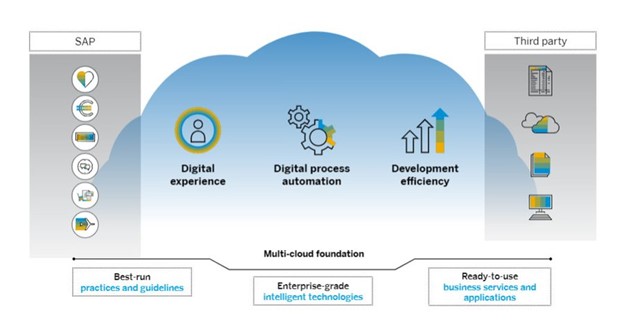
Development Efficiency
The Development Efficiency services of the BTP provide developers with a variety of features to code, manage, deploy and monitor custom cloud solutions. As the core of Development Efficiency, and really as the core of the BTP in general, lies multiple runtime environments that support a variety of coding languages. The runtime that will be used for most custom application logic is the Cloud Foundry.
The Cloud Foundry allows developers to choose from a variety of languages to begin coding their custom solutions. Available languages the run in the Cloud Foundry include Java, Node.js, Ruby, Go, Python, and PHP. The Cloud Foundry is also where the ABAP runtime environment is deployed, however the ABAP runtime (sometimes referred to as SteamPunk) requires a separate, additional service. The ABAP runtime supports the ABAP Strict coding language, which is a more secure and restrictive subset of the normal ABAP language available on S/4 systems. To code the various applications, users will primarily use Business Application Studio for non-ABAP applications, and connect directly to the ABAP Runtime with Eclipse for all ABAP Development.
In addition to the runtime environments, the Extension Suite provides a variety of quality-of-life services to make organizing, monitoring, and transporting applications much easier. A few services that would be useful when extending an ERP solution are:
Job Scheduler – Create one time or recurring jobs that will trigger the execution of an application or service within the BTP.
Alert Notification – Create or receive alerts when service encounter errors or unforeseen issues. Send alerts by email, text, launchpad notifications, or even transmit messages via API.
Cloud Transport Management – Manage transports between accounts of various development environments (for example, between development and staging Cloud Foundry environments).
SAP HANA Cloud – Manage SAP HANA cloud instance and create database level artifacts to take advantage of HANA features or optimize data access. In addition to allowing custom extensions to store required data, the SAP HANA Cloud can serve as the central repository for all data, in a “hub-and-spoke” data architecture model. In this way, the entire enterprise can have a single source or truth, across legacy systems, newer systems, cloud and on-premise alike.
Master Data Governance – SAP offers a specific service to implement the “hub-and-spoke” architecture mentioned above for master data, the Master Data Governance (MDG) service. This approach ensures that all enterprise systems are operating with the same version of master data. Additionally, the MDG simplifies existing master data integration while also greatly reducing the cost of adding new systems, since all systems have one point to integrate with to gain full access to the enterprises master data.
Digital Experience
The Digital Experience are less about development and more how the to present the applications to the customers/consumers. Things related to GUIs, document creation, modifying existing UI5 applications with low-to no code are found here. Businesses can pick and choose which services best suits their end-user delivery strategy. Some of the key services include…
– Dig Deeper –
SAP Extension Suite Overview
Q&A (Post your questions and get the answers you need)

Q. What is the difference between SAP AppGyver and SAP’s Business Application Studio?
A. Before we go into each tool, let’s set the stage that evolved the need for these tools to begin with. Companies all over the world have already set the stage for a broader scope of people doing work in what has traditionally been the developer realm.
Gartner, Inc. estimates that “by 2024, 80% of technology, products and services will be built by those who are not technology professionals.” This trend will bring up the number of nontraditional competitors to “one-third of technology providers.”
Several dimensions make it difficult for organizations to remain agile, innovative, and competitive and to accelerate citizen development as an additional source of innovation and delivery. One of the things we’ve learned again since last year with the COVID-19 pandemic is that business requirements are constantly changing and evolving.
Speed in implementing these changes is and will always be key to staying ahead of the competition. At the same time, IT landscapes get more complex, with companies having to maintain a growing number of tools and services. As a result, it will be more difficult to transform and adapt these applications. We also see that companies need to make changes despite limited development resources. In the future, organizations must manage increasing transformation investments with fewer resources.
Higher productivity but less coding
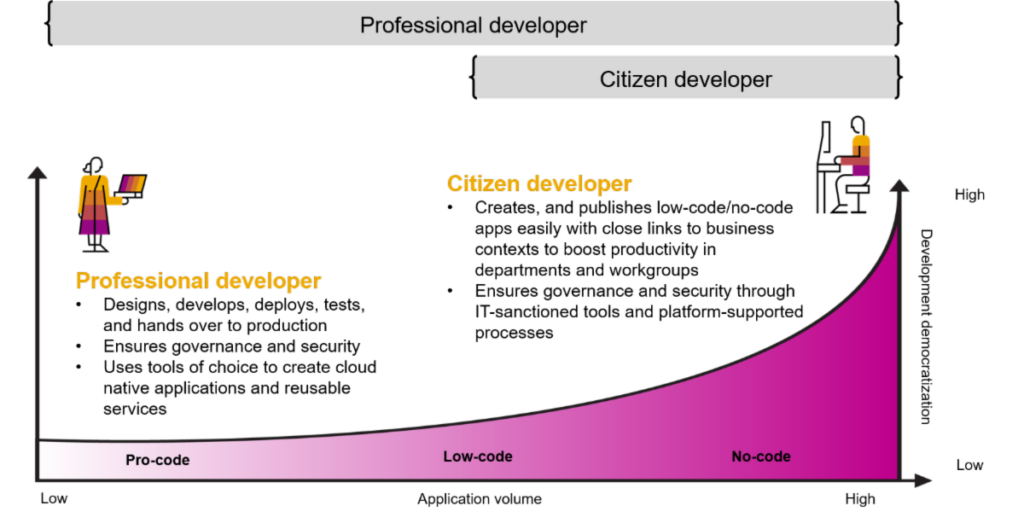
With the acquisition of AppGyver, SAP complemented their existing application development capabilities for citizen developers with a purely no-code approach. SAP AppGyver, as it was rebranded, brings in mobile and web app development capabilities that allow our customers to build highly sophisticated standalone applications or extensions without writing a single line of code. Its intuitive no-code user experience and drag-and-drop, one-click functionalities make it approachable and usable for non-technical users — a significant innovation.
Having looked at the impressive value SAP AppGyver provides to citizen developers, companies wanted their professional developers to accelerate their time to business outcomes with an enhanced development experience. With SAP Business Application Studio’s low-code perspective, SAP delivers a simplified application development journey also to the technical user. SAP Business Application Studio provides full-stack SAP application and BPT extension development with minimal coding effort. At the same time, professional developers can fall back in their familiar pro-developer environment. This approach allows change across the business, i.e., professional developers can support citizen developers whenever they are needed without changing the development environment.
Together with SAP AppGyver’s no-code approach, SAP Business Application Studio completes the unified developer experience for professional developers and citizen developers.
Let’s take a look at that continuum again, but this time fill in the tooling being used.
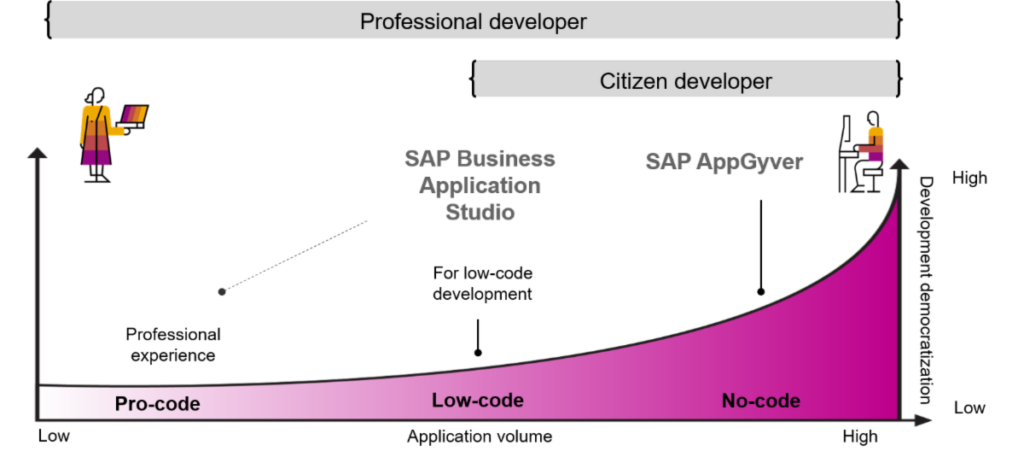
Together with SAP AppGyver’s no-code approach, SAP Business Application Studio completes the unified developer experience for professional developers and citizen developers.
Cheers!


